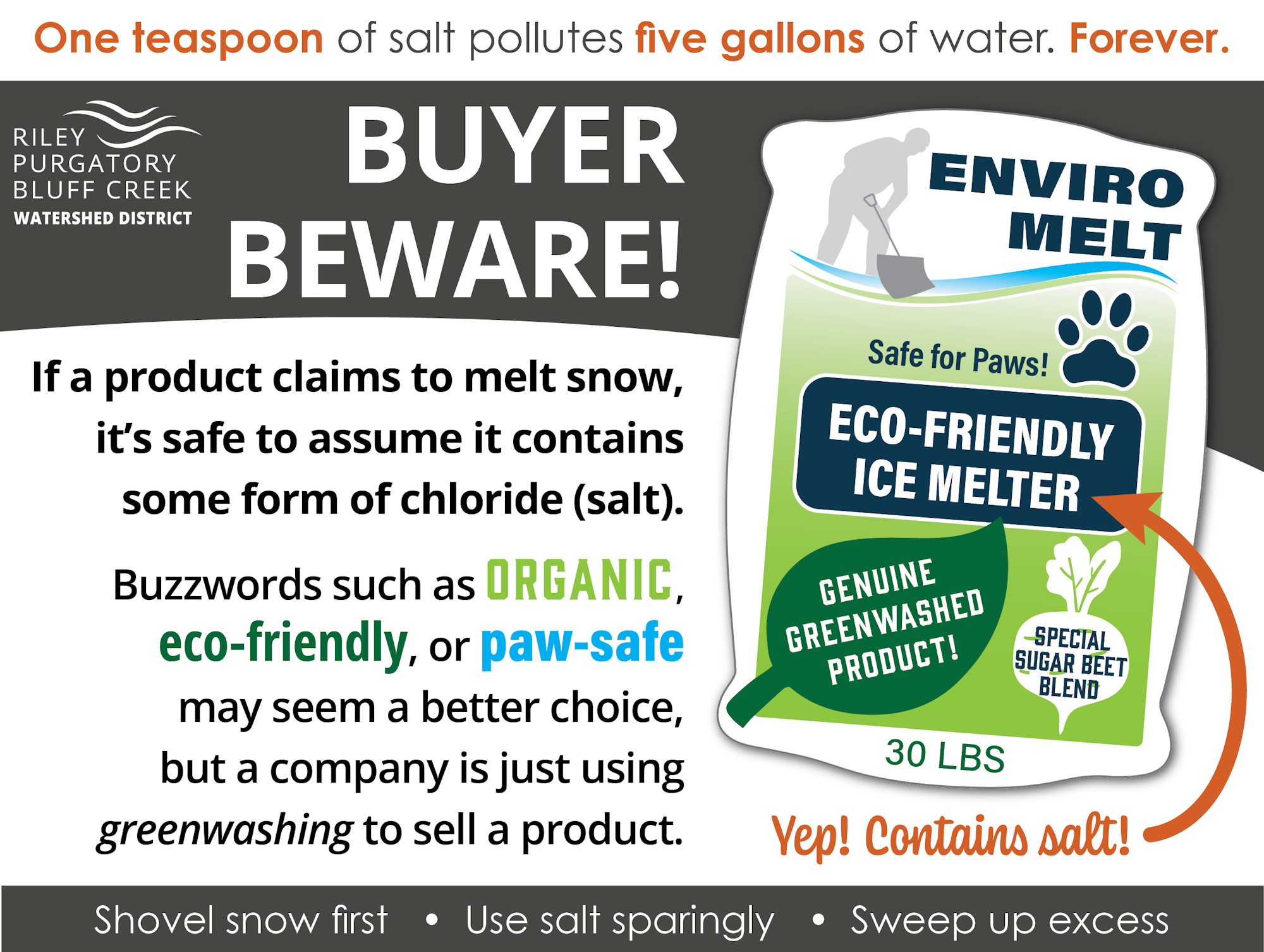Salt
What's the deal with salt?
Winter in Minnesota means sledding and snowmen, and it also means managing snow and ice on our driveways and sidewalks. Have you ever wondered what happens to the salt we put down to melt ice? It doesn’t go away!
Salt washes into stormdrains and flows through pipes to local lakes, streams, and wetlands, where it becomes pollution. Decreasing salt use is a powerful way to protect Minnesota’s waters.
Just one teaspoon of salt is enough to permanently pollute five gallons of water.
The Riley Purgatory Bluff Creek Watershed District partners with cities, the Minnesota Pollution Control Agency, and other organizations to host trainings for winter maintenance professionals and property managers. These workshops guide professionals in best practices for winter safety that also protect clean water.
Find a training.
Frequently Asked Questions
Click below to read answers to the most frequently asked questions.
You can also download a FAQ handout.A deicer is a product that melts snow and ice. Common names for deicers include winter salt, road salt, and chlorides. Chloride is the powerful chemical found in deicers that is responsible for melting, but it also causes damage to water, infrastructure, and vegetation
All deicers, even the "eco-friendly" ones, impact the environment. Salt is permanently accumulating in Minnesota’s water – in both groundwater and surface waters like lakes and streams. There is no practical way to remove salt from water. Just one teaspoon of salt permanently pollutes five gallons of water making it toxic to aquatic life and potentially impacting human health. Salt hurts pets and wildlife, changes soil structure, and damages infrastructure and vegetation.
Salt has already permanently contaminated groundwater in some areas of the state, and 75% of Minnesotans rely on groundwater for drinking water. Excess salt can affect the taste and healthfulness of drinking water. Twenty-seven percent of shallow groundwater monitoring wells in the Twin Cities Metro have chloride concentrations that exceed EPA drinking water guidelines. Thirty percent of Twin Cities wells have chloride concentrations that exceed the water quality standard.
Sadly, there is no "going away" for chloride pollution. Melting snow and spring rains wash winter salt products into stormdrains and nearby streams, lakes, wetlands. Once it's in the water, much of the salt stays put with levels growing each year.
Also, there's no practical way to remove the chloride once it's in our waterbodies.
The Low Salt No Salt approach supports you in making winter maintenance decisions that will reduce the need for salt on your property while still maintaining safety. You can reduce the need for deicing salts on your property at your own pace and comfort level.
To reduce your use of deicers:
- Shovel first to prevent ice formation
- Store snow where it won't melt and refreeze on walking surfaces
- Use the right amount of deicer (a 6-ounce mug is enough for a 20-foot driveway)
- Sweep up extra deicer to save for later use
Here are some simple ways to prevent formation of ice where you don't want it:
- Shove early and often. Remove snow before it becomes compacted and turns into ice on walkways, driveways, and parking lots. Foot and vehicle traffic quickly compact snow and create icy spots!
- Store snowpiles where they won't melt, drain, and refreeze on walkways, driveways, and parking lots.
- Redirect downspouts so that they do not drain onto walkways or other areas where the water can freeze and form ice.
- Identify low areas that collect water/ice in winter and create a slip hazard. Fence off or mark these areas in winter and fix drainage issues once weather allows.
Yes. In fact, a study by the University of Minnesota found that about 78% of salt applied in the Twin Cities for winter maintenance is either transported to groundwater or remains in the local lakes and wetlands. However, salt can also come from water softening, wastewater plant discharge, fertilizer, manure, and dust suppressants.
There is a point where additional salt does not yield better results - there's only so much surface area of ice that salt grains can make contact with. Putting down excess salt wastes money and may create a slip hazard for people walking on it.
If you're hiring someone to perform winter maintenance, look for a crew certified in MPCA’s Smart Salting techniques. A knowledgable crew can discern whether more salt means more safety or when it is simply wasteful. They are also trained to use other winter maintenance best practices that reduce the need for salt
Training and documentation of winter maintenance activities build a presumption of due care and makes it challenging for an injured party to prove negligence.
“Due care” is the conduct that a reasonable person will exercise in a particular situation, in looking out for the safety of others. Winter maintenance best practices are well-established and do not compromise safety. People can reduce their own vulnerability to slip-and-fall accidents by practicing due care such as wearing appropriate footwear, allowing extra travel time, and other reasonable efforts given the circumstances.
Property managers/owners can practice due care by implementing a written plan/policy, hiring trained professionals, and documenting weather conditions and operations.
Specific recommendations include:
- Developing a winter maintenance policy for your property.*
- Having a contract with your winter maintenance professional that includes clear maintenance expectations and requires proper documentation of conditions and activities.*
- Developing a winter maintenance plan specific to your property.*
- Hiring a certified applicator and requesting that your property manager take a Smart Salting course.
*Examples, model language, and templates for winter maintenance policies, contracts, and plans can be found here: www.pca.state.mn.us/water/statewide-chlorideresources.
All economically practical and effective deicers contain chloride. To remove ice without the use of a deicer, consider using a scraper tool to remove the ice mechanically. Better yet, reduce the build up of ice on your property by shoveling and plowing to remove snow before ice forms. And remember to keep the snow piled where it won’t melt and refreeze again on a sidewalk or driveway.
If you do use salt, sweep up excess salt once the ice is melted and salt is lying on bare pavement. Dispose of the salt in the garbage or save it to use with the next storm. If you only need traction, and do not need to remove snow or ice, you can use sand, grit, or kitty litter (non-scoopable). Remember to sweep up these products after the ice melts to avoid polluting our lakes and streams with these substances.

Are neighborhood lakes and streams impacted by salt?
Yes! The District has monitored chloride pollution in lakes for several years, and chloride levels are trending up in most lakes and streams. Check out water quality data summaries, including chloride, on our lake fact sheets. Looking for even more detail about water quality? Check out the most recent RPBCWD Water Quality Report on the Annual Reports page.
What are the impacts of salt use?

Aquatic Life - It takes only one teaspoon of road salt to permanently pollute five gallons of water, as chlorides do not break down over time. At high concentrations, chloride can deplete dissolved oxygen levels and be harmful to fish, aquatic plants, and other aquatic organisms.
Groundwater - Chlorides can infiltrate through soil into groundwater aquifers, affecting its taste and raising safety concerns about increased sodium content.
Plants - Salt applied to roads can damage roadside vegetation, and salty runoff can displace other much-needed nutrients in the soil, which can stunt growth and lead to toxic levels of chloride that interrupt photosythesis.
Soil - Salt-laden soil can lose its ability to retain water and store nutrients and be more prone to erosion and sediment runoff.
Pets and Wildlife - Road salt can look like a tasty treat to birds and other wildlife, which can be toxic. It may also irritate your pet's paws, and cause health problems if they eat it or lick it off their paws.
Infrastructure - salt can have corrosive effects on infrastructure, degrading roads and bridges and damaging vehicles hit by salty spray.
Video: How to reduce salt use & maintain safety
The video below summarize why everyone should be concerned about chloride pollution.
You can help!
Use the tips below to help decrease salt use around your home and be a part of the clean water solution.
Shovel first! Clear walkways and other areas before the snow turns to ice. The more snow you can remove manually, the less salt you will need to use, and the more effective it will be.
If you need to apply salt to pavement, scatter the salt widely, leaving space between grains of salt. A coffee mug of salt is enough for 60-70 feet of sidewalk, or two parking spots. A hand or push spreader helps too!
When the pavement temperature is below 15 degrees, most deicers doesn’t work. When cold temperatures are predicted, try to shovel and remove ice before it hits. Use sand, kitty litter (non-scoopable), or chicken grit for traction as needed.
Sweep up extra salt. Salt only works once it is dissolved. If you can see salt on your driveway, it isn’t doing any work. Sweep it up, and use it again next time.
Salt Smart Toolkit
Sadly, Minnesotans have become used to seeing piles of salt in winter. If you and others decrease the amount of salt used at your office, community of faith, or school campus, your community members might wonder why. They might even be concerned. The flyers in this kit are one way you can help share your salt smart actions, and show others how they can join in in protecting clean water.
A set of printable materials to hang on doors, windows, or tape to a salt bag, or hand out at the front desk.
To help you communicate your salt smart actions to others.
Local businesses, non-profits, office buildings, and faith-based organizations. However, anyone is welcome.


